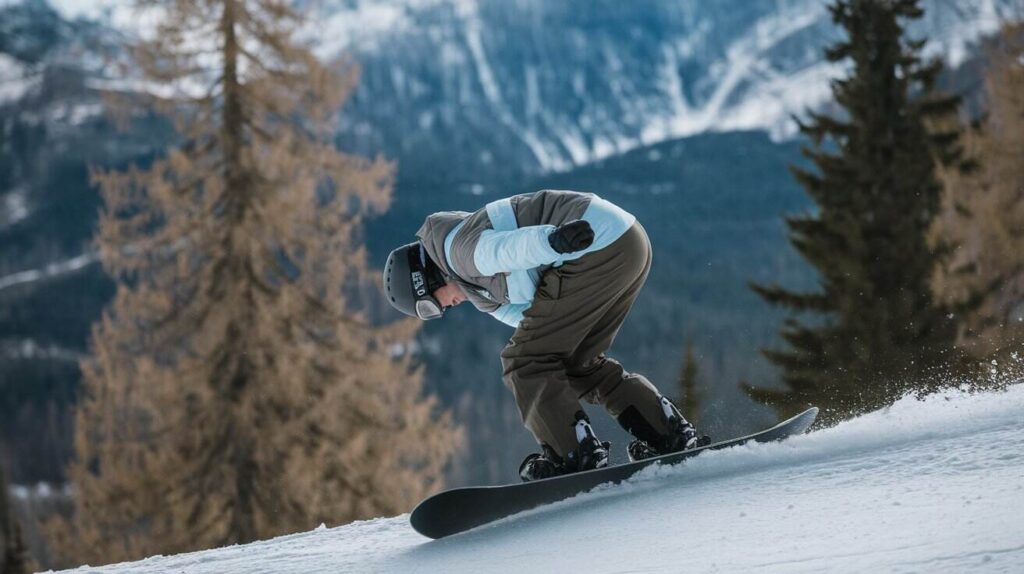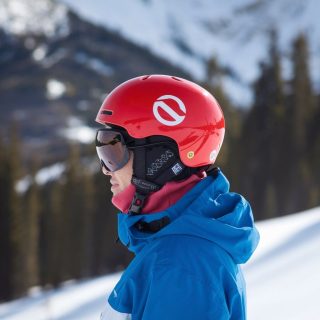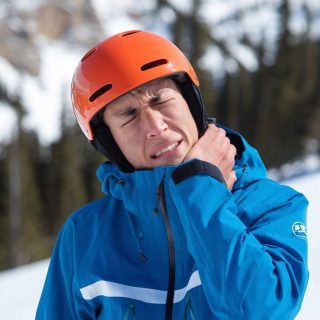Snowboarding can lead to neck pain when the tissues are strained due to poor posture, or as a result of a fall on the slopes.
Think of yourself after skiing all day and then, every time you turn your head, it pains. If you have a sore neck it reduces comfort on your trip since you might end up the whole trip with a sore neck if you have to sit in a car for instance.
In this article, we will outline some of the most frequent causes of neck pain and how you can take precautions to lessen your chances of pain while enjoying your snowboarding.
Why Does My Neck Hurt After Snowboarding? Understanding the Basic Anatomy
To grasp why your neck may hurt after snowboarding, it’s important to review some fundamental information about this area: Neck: Also known as the cervical spine, is made of seven small sized bones referred to as vertebrae. Some of these vertebrae are connected by muscles, tendons as well as ligaments in order to enable the different head motions.
.During snowboarding such muscles and ligaments can be pulled by movements, falls in an awkward position, or improper sitting. If they work too much or get hurt, then you should suffer discomfort or pain. The neck is also rich in nerves and these could become nerve compressed or even pinched during some rigorous exercising.In addition, pressure can accumulate from no additional risk factors at all, like from wearing a very heavy helmet, for example, or when the cold stiffens up the neck muscles causing soreness there.
Knowing more about the regions of your neck allows you to learn more about why your neck is sore after snowboarding and can help you avoid it.
Why Does My Neck Hurt After Snowboarding? Poor Posture on the Slopes
This is because when riding, you find that most people develop some bad habits of posture, which lead to this kind of pain. It is a fact snowboarding puts the body through a lot of stress and effort as such it is advisable to keep as relaxed as possible when on the board. If your neck muscles are not positioned correctly, and you are hunched over or stiff, it could lead to injury.
A lot of snowboarders are guilty of tilting their bodies well forward or turning their heads in funny angles to monitor the slope.

It puts a lot of pressure on the muscles and ligaments in your neck. These muscles get sore and are used up over time when you are snowboarding leaving the user with aches and joint pains after the activity.
Also, if you frequently bend your head down or ahead in a fixed position, your neck’s muscles are holding that tension. In order to reduce the possibility of developing a sore and stiff neck after snowboarding, it is possible to avoid neck pains by maintaining as much of the right posture as possible while at the same time ensuring that you do not tense up.
Whiplash: A Major Reason Why Your Neck Hurts After Snowboarding
Neck pain after snowboarding is usually caused by whiplash. This injury occurs when your neck suddenly gets jerked backward and forward, as in the case of a fall whilst skiing or snowboarding. The sudden movement squeezes muscles, ligaments and joints in your neck leading to aches, tightness or soreness.
Well, in snowboarding you have to fall anyway but what happens is at one moment your body might be moving in one direction and your head in the opposite; this leads to whiplash.

A simple slip is sufficient to bring on whiplash if, for example, your neck is not firmly supported, or if you did not see the fall coming.
Sometimes, the effects of whiplash may not be immediately observed by the casualty or diagnosed by the doctor. At the end of the day of snowboarding, you might have no problem, but the next morning your neck could hurt, stiff, or be stiff to move. It will make you understand how whiplash works in detail, and why you feel your neck pain when snowboarding and can guide you on how to go about the situation.
Helmet Fit: Could This Be Why Your Neck Hurts After Snowboarding?
An improperly sized helmet may be a contributing factor to neck pain after snowboarding. the helmet that rests on your neck wrong can exert pressure on your neck muscles.
If your helmet is too heavy, too tight, or does not sit comfortably on your head, your neck muscles are stretched to accommodate this weight. This, over time, poses a risk, to the muscles, and the consumer is likely to experience fatigue and sore muscles after a day spent skiing. The helmet can also twist and turn freely which will force your neck to bend and twist erratically as you snowboard.
For instance, to do away with neck pains, one has to ensure the helmet is well-fitted around the neck and the head, without straining the neck in the process. The helmet that fits you perfectly will surely safeguard you adequately and equally make a contribution to eradicating neck pains after snowboarding because your head will be in the right place.

Why Does My Neck Hurt After Snowboarding? The Role of Cold Weather Stiffness
Therefore, cold can be the chief reason why your neck will be a problem during snowboarding. When you are out in the cold during skiing the muscles and joints become rigid due to cold temperatures. Cold makes your muscles tense up thereby making them more susceptible to strains.
Cold can cause the neck muscles to tense up, meaning they are more likely to be injured when you move your neck or if you fall. A simple and brief exercise while snowboarding is holding a tense position and it would cause neck stiffness. Also, the cold might make one pull their shoulder up or pull their head down thus developing poor posture and a lot of strain on the neck.
However, to avoid the issue of neck pains, techniques that should be employed for muscle warmth and stretches should be followed. In order not to develop this type of neck pain, warm up and stretch both before and after each session of snowboarding, and when dressing, do not expose the neck to cold.
Preventing Neck Pain: Why Does My Neck Hurt After Snowboarding and How to Avoid It
Learning why your neck aches after snowboarding is important so that you don’t experience discomfort. Luckiness only there are some readily applicable measures that will go along way to minimizing ones risk of suffering a neck injury while skiing or snowboarding.
Improve Your Posture:
It is advisable to maintain an appropriate body posture and avoid a tense position when snowboarding. Stay as erect as possible and avoid falling forward, or twisting your head in a peculiar manner all through the stretch.
Choose the Right Helmet:
It concerns both size and fit. It is important here that head protection is effective and comfortable. Ensure the helmet fits well and isn’t tight, and does not cause excess weight on the neck.
Warm-Up and Stretch:
Before going for skiing, you will need to spend some time stretching your necks and shoulders before skiing. It decreases the chance of getting injured because it doesn’t keep your muscles stiff.
Take Breaks:
It is fun to perform snowboarding but you can get tired easily so make sure to rest when you must. This helps your muscles to rest and build up the strength to continue with the next line of action.
Stay Warm:
As for possible discomfort experienced in the area of the neck as a consequence of cold temperature situation, it is necessary to dress wearing at least two layers of clothing to keep muscles in this area both warm and flexible.
That way, you will minimize the likelihood of an occurrence of pain and discomfort when snowboarding – and you’ll be much happier on your trip!
Why Does My Neck Hurt After Snowboarding? When to See a Doctor
For anyone out there asking why their neck aches after snowboarding, then knowing when to see a doctor is a good place to start. Despite this, there are some other symptoms which could depict that the problem is severe and one needs to visit the doctor.

Persistent Pain:
However, if your neck pain persists even after a few days to most of the home remedies you should seek medical attention. Chronic pain might be a sign of a hidden injury requiring the attention of a doctor.
Severe Pain:
If the pain is acute it could be an indicator that you have pulled a muscle or injured your neck. This is often referred to as an ache and is usually a worse kind of pain as compared to simple soreness.
Numbness or Tingling:
If a person has some of the symptoms like numbness, tingle or weakness in the arms or hands s/he should go to the Doctor on the same day. They may be early signs of peripheral neuropathy or other conditions of the body.
Difficulty Moving:
If you struggle to twist your head to the side or if your neck feels like it has no flexibility see a physician, You will need the assistance of a physician to identify the problem.
Headaches:
If the neck pain is complemented by severe headaches there may be deeper issues that require intervention from a physician.
Knowing why your neck aches after snowboarding and when you should consult a doctor will help keep you healthy even when participating in your favorite winter activity.
Conclusion
Of course, snowboarding is fun, but it’s important to know what might make your neck ache. Discomfort can be caused by the anatomy of the neck, bad posture, whiplash, improper fitting of the helmet and stiffness resulting from cold climate. In appreciating these causes, the following precautions can help you avert pain in the slopes: So, identifying when medical attention is needed for any pain is very important. Read some recommendations for neck care and continue to have fun snowboarding!
FAQs
How long does snowboard whiplash last?
In general, slight symptoms would require about five to seven days to resolve once the individual imposes some restraint and requires extra care. A doctor should be consulted once symptoms are still present and bring about discomfort or if they become severe.
How do I protect my neck when snowboarding?
To reduce the impact on the neck during snowboarding ensure you have a properly fitted helmet to protect your head. Also while riding, keep a good riding posture avoiding tensing your shoulders and ensure that your head remains parallel to the spine. It will also pay a person to take breaks in between to at least extend his neck and rotate it as this will guard against any strains when the actual skiing activity begins.
Is it normal for the neck to hurt after skiing?
Yes, it’s normal for your neck to pain after skiing especially if you have been skiing for a long time or you have fallen several times. The pain may be due to certain muscles being overworked, one sitting in a wrong posture, or even when tension while skiing.
How do you stretch your neck when snowboarding?
For stretching the neck while snowboarding you should stand up and swivel your head to the side – try to touch your ear with your shoulder and stay like this for 15-30 seconds. You can also roll your head from side to side in a slow motion so as to release some tension. Make sure to avoid some form of tension in the shoulders while performing these stretches.
In general, slight symptoms would require about five to seven days to resolve once the individual imposes some restraint and requires extra care. A doctor should be consulted once symptoms are still present and bring about discomfort or if they become severe.
To reduce the impact on the neck during snowboarding ensure you have a properly fitted helmet to protect your head. Also while riding, keep a good riding posture avoiding tensing your shoulders and ensure that your head remains parallel to the spine. It will also pay a person to take breaks in between to at least extend his neck and rotate it as this will guard against any strains when the actual skiing activity begins.
Yes, it’s normal for your neck to pain after skiing especially if you have been skiing for a long time or you have fallen several times. The pain may be due to certain muscles being overworked, one sitting in a wrong posture, or even when tension while skiing.
For stretching the neck while snowboarding you should stand up and swivel your head to the side – try to touch your ear with your shoulder and stay like this for 15-30 seconds. You can also roll your head from side to side in a slow motion so as to release some tension. Make sure to avoid some form of tension in the shoulders while performing these stretches.

